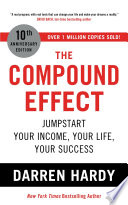

The Compound Effect emphasizes that small, seemingly insignificant choices made on a daily basis can lead to significant results over time. The book illustrates how habits, whether good or bad, accumulate and compound. For instance, choosing to exercise for just 20 minutes a day may seem trivial, but over a year, that choice can lead to substantial health benefits. Conversely, small negative choices, like skipping workouts or indulging in junk food, can lead to detrimental outcomes. The author encourages readers to be mindful of their daily choices and to recognize that they are the architects of their own futures. By making conscious decisions consistently, individuals can harness the power of the compound effect to create positive change in their lives.
Continue readingConsistency is a central theme in The Compound Effect. The author argues that success is not the result of grand gestures but rather the accumulation of small, consistent actions. He provides examples of successful individuals who achieved their goals through persistent effort over time. The book emphasizes the importance of developing routines and sticking to them, even when motivation wanes. By committing to consistent actions, individuals can build momentum and ultimately achieve their desired outcomes. This idea reinforces the notion that lasting change is not instantaneous; it requires dedication and a willingness to persevere through challenges.
Continue readingTracking progress is a practical strategy discussed in The Compound Effect. The author suggests that individuals should monitor their actions and results to gain insight into their behaviors. By keeping a journal or using apps to track habits, readers can identify patterns, recognize areas for improvement, and celebrate successes. The act of tracking serves as a form of accountability, making it easier to stay on course toward goals. This idea highlights the importance of self-awareness and reflection in the journey toward personal and professional growth. By understanding what works and what doesn't, individuals can make informed adjustments to their strategies.
Continue readingThe Ripple Effect is a powerful concept in The Compound Effect that illustrates how one positive change can lead to a series of beneficial outcomes. The author explains that when individuals make a commitment to improve one aspect of their lives—such as health, finances, or relationships—the positive changes can extend beyond that initial area. For example, someone who starts exercising may find that they have more energy, which leads to increased productivity at work, better relationships, and improved mental health. This interconnectedness emphasizes the idea that personal growth is holistic; improvements in one area can create a cascading effect that enhances overall well-being.
Continue readingHabits play a crucial role in The Compound Effect. The author discusses how habits are formed and how they can be changed. He emphasizes that understanding the cue-routine-reward cycle is essential for habit formation. By identifying triggers that lead to certain behaviors, individuals can work to replace negative habits with positive ones. The book provides practical strategies for habit formation, such as starting small, focusing on one habit at a time, and using rewards to reinforce positive behaviors. This idea underscores the importance of being intentional about the habits we cultivate, as they ultimately shape our lives and results.
Continue readingThe Compound Effect highlights the importance of environment in shaping behavior. The author argues that our surroundings play a significant role in determining our choices and habits. By creating a supportive environment that aligns with our goals, we can enhance our chances of success. This might involve surrounding ourselves with positive influences, removing distractions, or setting up systems that facilitate good habits. The book encourages readers to take a proactive approach in designing their environment to support their aspirations. This idea reinforces the notion that we are not just passive recipients of our circumstances; we have the power to shape our environments to foster positive outcomes.
Continue readingLong-term thinking is a fundamental principle in The Compound Effect. The author advocates for a shift in mindset from seeking instant gratification to embracing delayed rewards. Many individuals fall into the trap of prioritizing short-term pleasures over long-term goals, which can hinder progress. The book encourages readers to cultivate patience and to understand that meaningful change takes time. By focusing on long-term objectives and recognizing that the compound effect works in both positive and negative directions, individuals can make more informed decisions that align with their ultimate aspirations. This idea promotes a sense of resilience and commitment to the journey of personal growth.
Continue reading